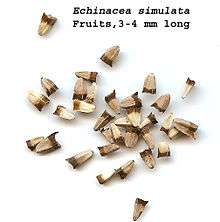Echinacea simulata
| Echinacea simulata | |
|---|---|
 | |
| Scientific classification | |
| Kingdom: | Plantae |
| (unranked): | Angiosperms |
| (unranked): | Eudicots |
| (unranked): | Asterids |
| Order: | Asterales |
| Family: | Asteraceae |
| Tribe: | Heliantheae |
| Genus: | Echinacea |
| Species: | E. simulata |
| Binomial name | |
| Echinacea simulata R.L.McGregor | |
| Synonyms[1] | |
| |
Echinacea simulata Wavy-leaf purple coneflower or Pale purple coneflower is a North American species of plants in the sunflower family.[2]
Echinacea simulata is very similar to E. pallida except that it has yellow pollen grains. Plants growing 50 to 100 cm (20-40 inches) tall from branched fusiform taproot. The foliage and stems with spreading hairs sparsely to densely distributed. The stems are mostly green or purple mottled. The basal leaves with petioles 4–20 cm long and the blades 3 or 5-nerved some leaves with 1 nerve, linear to lanceolate and 5–40 cm long and 0.5–4 cm wide. The leaf bases tapering gradually with leaves having entire margins, usually with ciliate hairs. Normally single flower heads produced on peduncles 20–40+ cm (8-16 inches) long. Phyllaries or bracts below the flower heads lanceolate to ovate, 7–15 mm wide and 1.5–3.5 mm long. The flowers with paleae 10–14 mm long with pinkish to purple tips, incurved and sharp-pointed. Ray corollas normally soft rose to pink colored but also rarely off white. The laminae are drooping to reflexed, 40–90 mm long and 4–7 mm wide, without hairs or sparsely hairy on the undersides. The flower heads are conic to hemispheric, 20–30 mm wide and 20–30 mm tall with Disc corollas 5–6.5 mm long, lobes pink to purplish. The seeds are produced in angled fruits called Cypselae that are tan and 3–4.5 mm long, with smooth surfaces, normally without hairs. One seed is produced per fruit and the seeds are rounded and gray-tan.[2]
Echinacea simulata is native to the eastern central states of the United States including Arkansas, Georgia, Illinois, Kansas, Missouri and Tennessee. It is found growing in rocky soils on open to wooded hillsides and prairies. Blooming in late spring to midsummer with some blooming into late summer, in the fall goldfinches feed on the seeds they remove from the dried cones.
